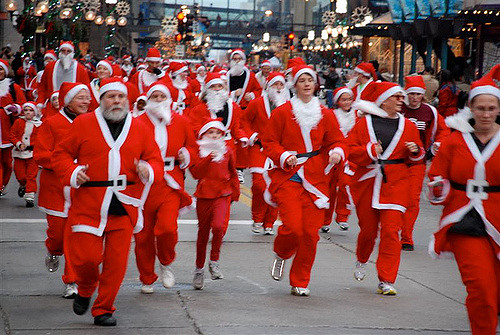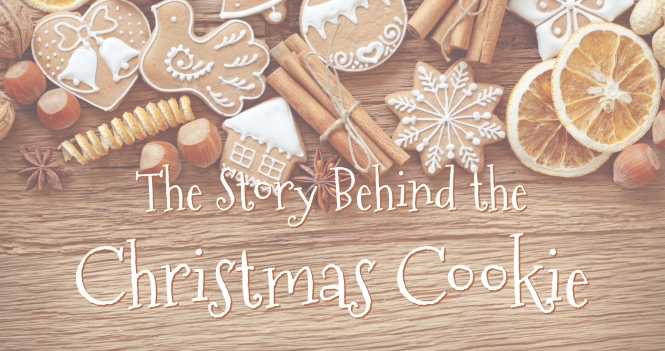Traditions are the little repeated acts that help unify a family, a community, or a country. Many of us think of things like starting an Advent calendar, dropping anonymous gifts on doorsteps, or leaving cookies out for Santa Claus. While all these traditions are well and good, we’ve compiled a short list of 5 holiday traditions from around the world that may strike many people as odd.
Japan

via KFC
Many, many Japanese people dine at KFC on Christmas Eve. So many, in fact, that some people advance order their meals as early as October! To make the holiday dining experience even more festive, some locations offer chocolate cakes and sparkling wine along with the original 8-piece bucket. This crispy-fried tradition was born when a 1974 ad campaign titled “Kentucky for Christmas” suggested KFC’s fried chicken makes the ideal holiday meal. This tradition is made even more fascinating when we consider that the vast majority of Japanese people don’t celebrate Christmas. Talk about the power of good advertising!
Greece
While the 12 Days of Christmas in America are an opportunity for gift giving, pre-holiday sales, and other exciting lead-ins to Christmas, they take on a much more frightful tone in Greece.
According to Greek folklore, the kallikantzaros emerges from its underground lair and is able to walk the earth during the 12 Days of Christmas (Dec. 25 – Jan. 5). This nocturnal, goblin-like creature wreaks havoc wherever it goes, so Greek people have a variety of means to deter it. One method is to leave a colander on the porch at night, because the kallikantzaros won’t be able to count all the holes before the sun comes up and it must hide again.
Latvia

via Pinterest
During Ziemassvētki, or Christmas in Latvia, a variety of pagan, religious, and modern traditions culminate in one unique holiday celebration. The strangest, perhaps, is the tradition of mummers. Mummers are people dressed as animals and other more macabre creatures—like the living dead—who travel from door to door offering blessings, encouraging fertility, and scaring away evil spirits. Residents of the home must give treats to the mummers in order for their blessings to take effect.
Guatemala
The tradition of La Quema del Diablo, or “the Burning of the Devil” is uniquely Guatemalan. Since it is believed evil spirits lurk in the dark, dirty corners of the home, the people of Guatemala spend the first week of December sweeping and deep-cleaning. The debris is piled outside the home and topped with an effigy of the devil. On December 7, everyone lights their piles at the same time, sending the devil and his minions away so the people may enjoy the Feast of the Immaculate Conception the following day.
United States

jmehre via Flickr
What began in Philadelphia as 40 people in Santa suits going out for a brew has turned into a national tradition. The Running of the Santas is touted as a charity event officially held in several large cities. Smaller cities and towns across the country conduct their own versions of the tradition, which is ultimately a creative spin on the bar crawl. Featuring live music, games, and of course, copious amounts of booze, the Running of the Santas sends thousands of people dressed as Santa spilling into the streets in the weeks before Christmas.
No matter what traditions you hold dear around the holidays, the important thing is to keep practicing them. The only way for future generations to enjoy these small, repeated acts is for us to keep repeating them. It’s never too late to start a new tradition, either! If any of these traditions (or any of the other 30 listed here) strike your fancy, your only challenge will be convincing your family or friends to join in.



 The traditional flavors of Christmas cookies are spicy, nutty, and fruity. These types of ingredients were used in the Middle Ages when cooks prepared celebratory cakes of cinnamon, ginger, pepper, almonds, and dried fruit. It wasn’t until lebkuchen, or gingerbread, made its way from Germany to Queen Elizabeth I that the Christmas cookie began to take shape. At this point in time, Christmas had already eclipsed the solstice as the most popular winter celebration, so it was no surprise when Elizabeth I wished to honor her courtiers with the gift of having her cooks fashion ginger cookies in their likeness. This is how gingerbread men became a Christmas staple.
The traditional flavors of Christmas cookies are spicy, nutty, and fruity. These types of ingredients were used in the Middle Ages when cooks prepared celebratory cakes of cinnamon, ginger, pepper, almonds, and dried fruit. It wasn’t until lebkuchen, or gingerbread, made its way from Germany to Queen Elizabeth I that the Christmas cookie began to take shape. At this point in time, Christmas had already eclipsed the solstice as the most popular winter celebration, so it was no surprise when Elizabeth I wished to honor her courtiers with the gift of having her cooks fashion ginger cookies in their likeness. This is how gingerbread men became a Christmas staple.
